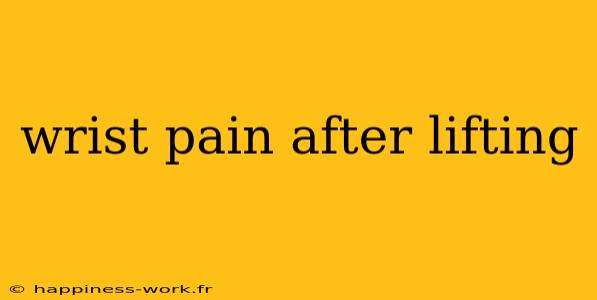Wrist pain after lifting weights can be a common issue that many gym-goers and athletes experience. Whether you're a beginner or a seasoned lifter, understanding the underlying causes, effective remedies, and preventive measures can keep you training safely and efficiently.
What Causes Wrist Pain After Lifting?
Wrist pain during or after lifting can arise from various factors. Here are some common causes:
1. Improper Technique
Q: How can improper lifting techniques lead to wrist pain?
A: Lifting weights with improper form can put unnecessary stress on your wrists. For example, using a grip that's too wide or too narrow can strain the wrist joint. Always focus on maintaining proper form to distribute weight evenly and minimize stress.
2. Overuse Injuries
Q: Can repetitive lifting lead to wrist injuries?
A: Yes, repetitive strain from lifting weights can lead to overuse injuries, such as tendonitis or strain. This is especially true if you frequently lift heavy weights without allowing your wrists adequate recovery time.
3. Weak Muscles and Ligaments
Q: Do weak wrist muscles contribute to pain?
A: Absolutely. Weakness in the muscles and ligaments surrounding the wrist can lead to instability and pain. Strengthening exercises can help build endurance in these muscles.
Remedies for Wrist Pain
If you experience wrist pain after lifting, consider these remedies:
1. Rest and Ice
- Rest your wrist from lifting to allow it to heal.
- Apply ice for 15-20 minutes to reduce swelling and inflammation.
2. Compression and Elevation
Using a compression bandage can help minimize swelling, while elevating the wrist can promote fluid drainage and reduce pain.
3. Over-the-Counter Pain Relief
Nonsteroidal anti-inflammatory drugs (NSAIDs), like ibuprofen or naproxen, can help relieve pain and reduce inflammation.
4. Gentle Stretching and Strengthening Exercises
After a few days of rest, begin gentle stretches. For example:
-
Wrist Flexor Stretch: Extend one arm forward, palm up, and gently pull back on your fingers with your other hand.
-
Wrist Extension Stretch: With your palm facing down, use your opposite hand to gently push your fingers back.
5. Consult a Professional
If the pain persists, consider consulting a physiotherapist or healthcare provider for personalized advice and treatment.
Prevention Tips
Preventing wrist pain while lifting is crucial for long-term fitness. Here are some tips:
1. Use Proper Form
Always ensure you're using the correct lifting technique. Consider working with a personal trainer to learn safe lifting strategies.
2. Warm-Up and Cool Down
Engaging in a proper warm-up and cool-down routine can prepare your muscles and joints for intense activity and facilitate recovery afterward.
3. Incorporate Strength Training for Wrists
Adding wrist-specific exercises, such as wrist curls and reverse wrist curls, into your routine can strengthen your wrists and help prevent injuries.
4. Gradual Progression
Avoid suddenly increasing the weight you lift. Instead, gradually add more weight to give your muscles time to adapt.
5. Use Supportive Gear
Consider using wrist wraps or braces when lifting heavy weights to provide extra support.
Conclusion
Wrist pain after lifting can be both frustrating and limiting for those who love to work out. By understanding the causes and implementing effective remedies and prevention strategies, you can continue your fitness journey without interruption. Remember to listen to your body and adjust your workout routine as necessary.
For a more thorough understanding of wrist pain management and to explore various lifting techniques, consider checking resources like WikiHow, which provides helpful tips and answers to common questions about weightlifting. Always consult with healthcare professionals for specific advice tailored to your needs.
Attribution: This article integrates information and insights from WikiHow articles about common questions related to wrist pain during weightlifting, under the authorship of their team, ensuring accurate and relevant content for readers.
